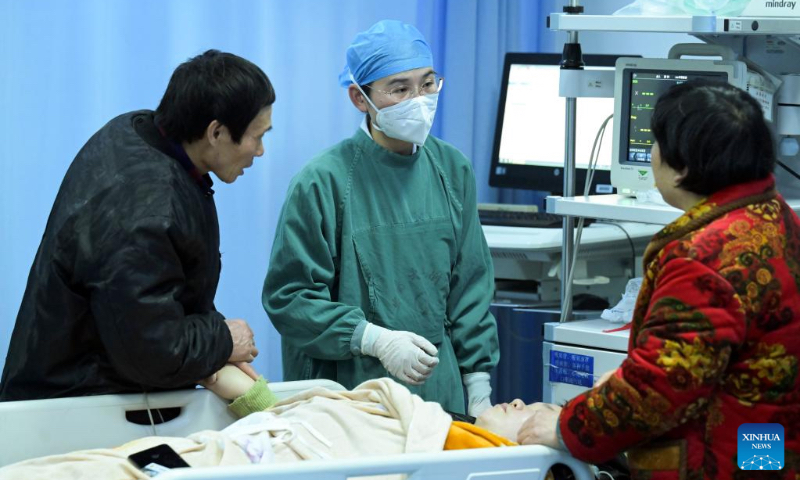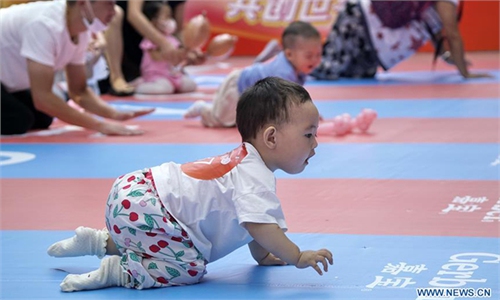Localities across China further explain health insurance reform
Interpretations intended to dispel public misunderstanding

A medical worker talks with the relatives of a patient at the emergency department of the Second Affiliated Hospital of Anhui Medical University in Hefei, east China's Anhui Province, Jan. 21, 2023. Medical staff stick to their posts during the Spring Festival holiday. (Xinhua/Zhou Mu)
More provinces and cities across China, including Southwest China's Sichuan and Northeast China's Heilongjiang provinces as well as Wuhan in Central China's Hubei Province, Xi'an in Northwest China's Shaanxi Province, have published their detailed interpretation of the health insurance reform in a bid to dispel public misgivings as the reform has sparked heated discussion since details of implementation were published recently.
Insiders said the reform of the medical insurance system is to make full use of relevant funds and improve the overall operation efficiency, so that those people in need, especially the elderly, can get more reimbursement, and reduce the economic burden of outpatient services and medicine purchases.
This reform is intended to adapt to the development stage of China's medical insurance and to improve the objective needs of the public's medical insurance benefits, experts said, refuting some Western media outlets' claims such as that the healthcare system has been strained by three years of COVID-related expenses.
The outpatient mutual aid security mechanism fully embodies the participation and benefit of social insurance for all, they noted.
China's health insurance system for urban employees and retirees consists of two parts: mandatory personal accounts with contributions from both employees and employers that mainly pay for ordinary outpatient services; and a pooled fund contributed by employers that is used to reimburse hospitalization bills, outpatient bills for serious diseases, and expenses for some chronic diseases, according to the Xinhua News Agency.
After the reform, money that employers deposit into employees' personal accounts will be directly paid to the pooled fund in order to support the reimbursement of ordinary outpatient medical bills.
The State Council, China's cabinet, rolled out the guiding instruction for the reform in April 2021.
In response to the issues of public concern in promoting the reform, the Wuhan Municipal Healthcare Security Administration issued a detailed interpretation on Tuesday.
This reform has increased preferential assistance to special groups. No minimum payment standard has been set for inpatient medical expenses of disabled people who are given minimum living allowances, and the proportion of payments from the pooled fund for employees' medical insurance has been raised by 2 percent.
For eligible medical assistance recipients whose out-of-pocket medical expenses exceed 7,000 yuan ($1,015) and who are at risk of returning to poverty after comprehensive coverage by the three systems of basic medical insurance, supplementary medical insurance and medical assistance, preferential assistance will be granted at a rate of 50 percent, with an annual limit of 30,000 yuan, according to the administration.
Under the new policy, the number of chronic diseases eligible for outpatient reimbursement in Wuhan will be expanded from 32 in 28 categories to 70 in 37 categories.
Separately, the Sichuan Provincial Healthcare Security Administration recently issued an interpretation.
Since the reform, the amount deposited each month into personal accounts of the insured people will be reduced in the current period, but the outpatient treatment services will improve, and the people in need will benefit more, the Sichuan authority said.
After the reform, the scope of use is also extended to family members. In addition to being used by the insured personnel themselves according to regulations, the personal medical accounts can also be used to pay the medical expenses of their family members.
Also, the personal account accounting method is more equitable, the Sichuan authority noted.
Both the Sichuan and Wuhan healthcare authorities pointed out that the reform is not being taken because healthcare funds are running out, saying there is no need for insured people to worry about this.
In recent years, Sichuan's medical insurance fund has been in balance and operating steadily. By the end of 2022, the province's employee basic medical insurance pooling fund had accumulated a balance of 146.2 billion yuan.
A woman who works in a Beijing hospital surnamed Wang told the Global Times that elderly people indeed benefit the most from the reform. Wang's father, who always purchases medicine at hospitals and pharmacies, can get more reimbursement after the reform.
"Previously, my father had to pay by himself his medical expenses surpassing the limit of 20,000 yuan, but this year, he can get part of the expense surpassing 20,000 yuan reimbursed," Wang said.
Liao Zangyi, associate professor at the School of Politics Science and Public Administration at the University of Political Science and Law, told the Global Times on Wednesday that "it is essentially a game between immediate short-term losses and future long-term gains." Liao noted that for individuals, their medical costs will not be raised due to the reform.
Liao also pointed out the necessity of reforming China's health insurance system, citing its unreasonable structure.
The balance of the medical insurance fund in 2021 was 3.6 trillion yuan, official data showed, of which one-third belonged to individual accounts, meaning that portion of money could not be used by others.
"Money in individual accounts could not play the role of mutual aid in social insurance, and it is difficult to deal with the economic risks brought about by disease only with individual ability," said Liao, noting that only by jointly bearing and resolving the risk of disease on the whole-of-society level, the redistribution function of social security could be better reflected.

